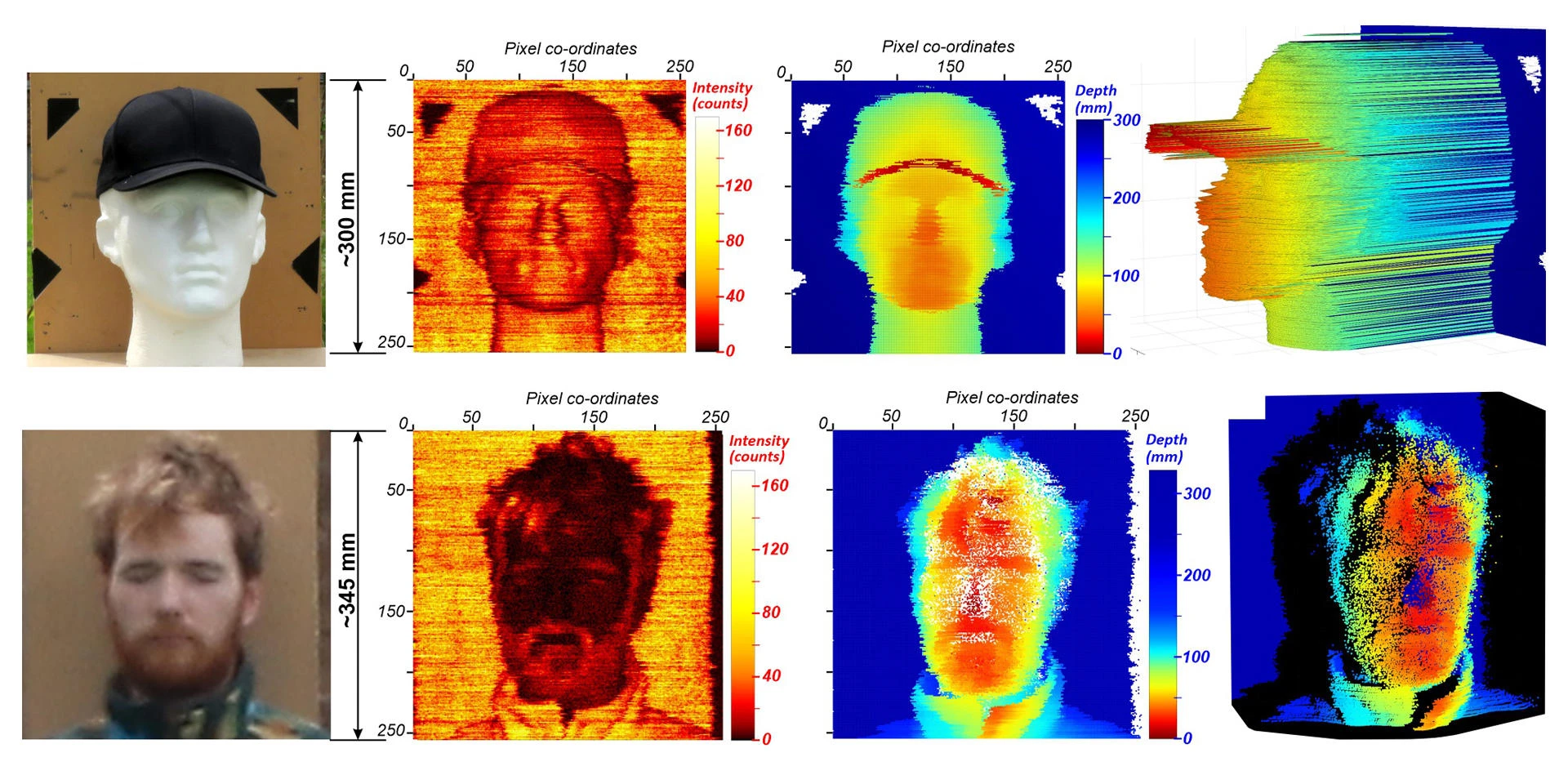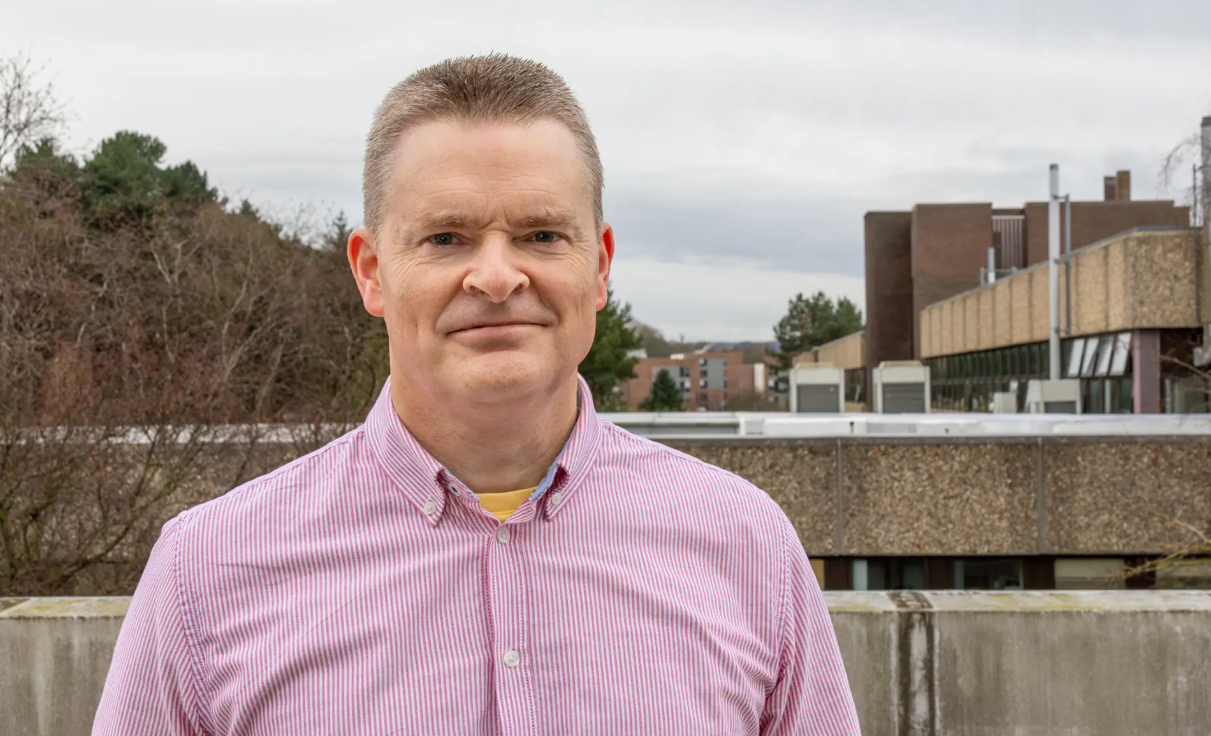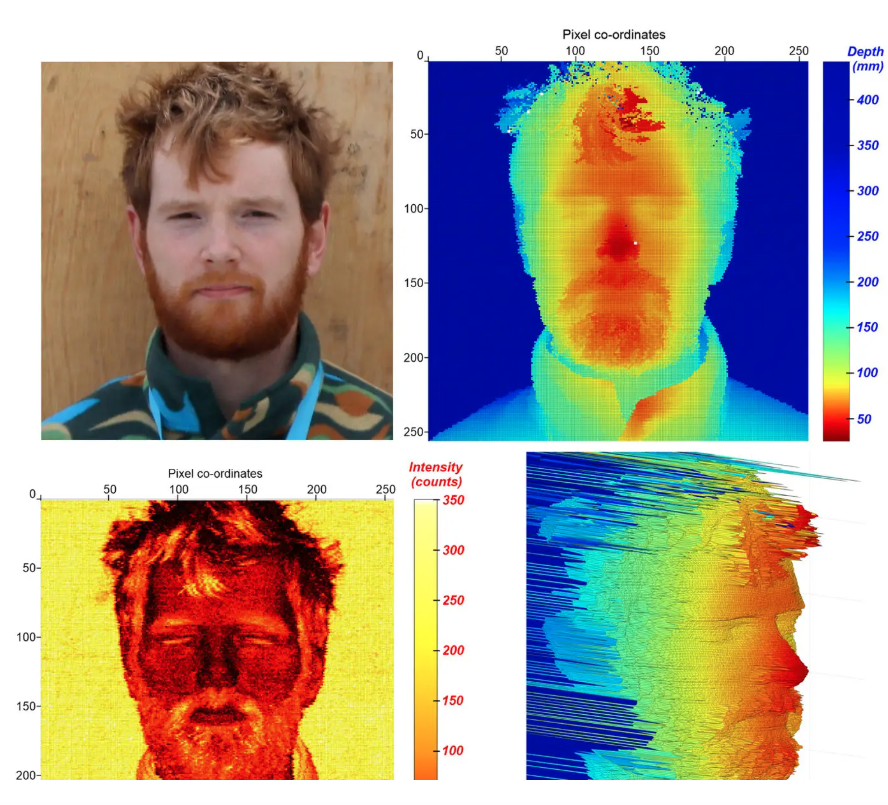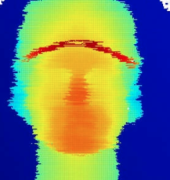日本語で読みたい方は、 google chromeで開き、
画面上で右クリックをして、「日本語に翻訳」をクリックしてください
 Depth scans from 325 metres away of a life-sized polystyrene head and research co-author Gregor Taylor.
Depth scans from 325 metres away of a life-sized polystyrene head and research co-author Gregor Taylor.Scientists have developed a detection system that could vastly improve the accuracy of human facial and activity recognition at long distances and through obstructions like fog, smoke or camouflage.
The researchers say their sensitive light detection and ranging (LiDAR) system can generate high-resolution three-dimensional images with double the efficiency of similar LiDAR systems being developed by other research groups, and at least 10 times better image resolution.
At 325 metres – the length of around three soccer pitches – researchers were able to 3D image the face of one of their co-authors in millimetre-scale detail.
The same system could be used to accurately detect faces and human activity at distances of up to one kilometre – equivalent to the length of 10 soccer pitches – the researchers say.
The results of our research show the enormous potential of such a system to construct detailed high-resolution 3D images of scenes from long distances in daylight or darkness conditions.
The research is published in the optics and photonics journal Optica and is a collaboration between the Single-Photon Group at Heriot-Watt University in Edinburgh, Scotland, led by quantum photonics expert Professor Gerald Buller, using equipment developed by NASA’s Jet Propulsion Laboratory (JPL) at California Institute of Technology and by Massachusetts Institute of Technology (MIT) in the United States, and by the James Watt School of Engineering at the University of Glasgow in Scotland.
Lead author Dr Aongus McCarthy is a specialist in optical and optomechanical design and a Research Fellow at Heriot-Watt’s Institute of Photonics and Quantum Sciences (IPaQS). He said: “The results of our research show the enormous potential of such a system to construct detailed high-resolution 3D images of scenes from long distances in daylight or darkness conditions.
“For example, if someone is standing behind camouflage netting, this system has the potential to determine whether they are on their mobile phone, holding something, or just standing there idle. So there are a number of potential applications from a security and defence perspective.”

The system uses pulses of laser light to measure the distances to objects in a scene. The team’s breakthrough involved being able to measure the time it took for a laser pulse to travel from the system to the object and back with an accuracy of approximately 13 picoseconds – a picosecond being one million millionth of a second. This timing is around 10 times better than the researchers had been able to do previously.
“The timing is really phenomenal,” Dr McCarthy explained. “It allows us to measure variations in depth very, very accurately – on a millimetre scale – which means we can distinguish between closely separated surfaces at very long distances.”
The system could lead to ‘step change improvements’ in applications such as facial and human activity recognition, and the imaging of scenes through ‘clutter and atmospheric obscurants,’ the researchers say.
A key advantage of the system is being able to accurately measure distances in broad daylight – when scattered light from the sun typically has a negative impact on the measurement process. By using a laser wavelength greater than can be seen by the naked eye – at 1550 nanometres – the daylight background is significantly reduced. This wavelength is also ideal for very high transmission in the atmosphere and in optical fibres.
Another advantage is that the laser output of the system is low power and ‘eye safe’ – meaning the laser beams from the system are safe to look at from any distance.

The researchers tested their system at three distances they could see from their rooftop laboratory. These were a neighbouring rooftop 45 metres away, a location on the ground 325 metres away and a distant radio mast exactly one kilometre away. It was at the 45 metre and 325 metre locations that research co-author Gregor Taylor posed while his colleagues scanned his head.
Dr McCarthy said he would now like to test the system over much longer distances.
“Could we recognise a vehicle type at 10 kilometres, whether it’s a car or a van or a tank?” Dr McCarthy asked. “These kind of distances would be of real interest.”
Dr McCarthy said the system could also be used to monitor the movement of buildings or rock faces to assess subsidence or other potential hazards.
The team built the system using a highly advanced detector developed by NASA’s Jet Propulsion Laboratory and Massachusetts Institute of Technology, which are well known for their groundbreaking scientific and technological research. This detector, called a superconducting nanowire single-photon detector (SNSPD), has to be cooled to a very low temperature of approximately minus 272 degrees Celsius – or 1 Kelvin – the base unit of thermodynamic temperature measurement. It then becomes ‘superconducting’ and has no resistance to electrical current flow until a photon of light lands on it.
The special ‘cryocooler’ fridge that cooled the team’s detector to the low temperature to carry out their research was another crucial component of the research.
This compact cooling system was designed and developed by the Quantum Sensors group of Robert Hadfield, Professor of Photonics at University of Glasgow’s James Watt School of Engineering.
The research was funded and supported by the UKRI Engineering and Physical Sciences Research Council (EPSRC), the European Research Council (ERC), the DARPA DSO Invisible Headlights program, the NASA ROSES-APRA program, and the Alliance for Quantum Technologies INQNET framework.
The research paper is entitled, High-resolution long-distance depth imaging LiDAR with ultra-low timing jitter superconducting nanowire single-photon detectors.
Contact
Victoria Masterson
Media Relations Officer
出典:
https://www.hw.ac.uk/news/2025/facial-recognition-breakthrough-could-mean-step-change-for-security-and-defence-detection
ご参考:
(株)光響が提供する製品・サービス情報:
・LiDAR(バックパック型・超高点群密度・ソリッドステート)
・ドローン球体ガード/イワサキドローン
・フェムト秒レーザー各製品
・Light Conversion製CARBIDEの3波長フェムト秒レーザー
・半導体レーザー
・量子コンピュータ関連製品
・波長板 関連製品
・OTDR関連製品
・VCSEL関連製品
・プロファイラ関連製品
・特殊レーザー光源 関連製品
・パワーメーター 関連製品
・分光器 関連製品
・グレーティング関連製品
・温度コントローラー関連製品
・レーザーマーカー関連製品
・ソフトウェア関連製品
・光学結晶 関連製品
・コーティング関連製品
・融着機 関連製品
・オプトメカニクス 関連製品
・光計測器 関連製品
・光学部品 関連製品
・LDドライバー / レーザーアセンブリ関連製品
・レーザー光源 関連製品
・ファイバー関連製品
・ファイバー部品/関連製品
・テラヘルツ関連製品
・医療関連製品
・光通信関連製品
・極微細用SLM型グリーンレーザーマーカー(光響製)
・超高精密フェムト秒レーザー加工機(光響製)
・レーザマーカー(光響製)
・ハンディ式レーザー溶接機(光響製)
・高精度ファイバーレーザー切断機(光響製)
・レーザークリーナー(光響製)
In case of addition or removal of the article, please contact us as below:
info@symphotony.com
記事の追加及び削除:
記事の追加あるいは削除を希望される場合、お手数ではございますが、
以下窓口までご連絡ください。
info@symphotony.com
この情報へのアクセスはメンバーに限定されています。ログインしてください。メンバー登録は下記リンクをクリックしてください。

